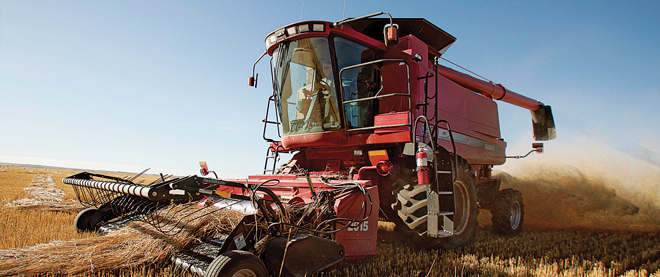Whither the wheat board?
Australia abolished theirs. Are we next?
Todd Korol/Reuters
Share

In 2008, the Australian Wheat Board, still staggering from a scandal over kickbacks to Saddam Hussein, was stripped of its powers as the sole lawful bulk exporter of that country’s wheat. This left Canada as the lone developed nation with a legally protected “single desk” export buyer-seller—the Canadian Wheat Board. With a minority government in Ottawa, the board’s grip on Prairie wheat was unshakeable. But now Stephen Harper’s Conservatives have a majority, with the corresponding freedom to rewrite statutes. And they intend to take Canadian wheat growers down the same path as Australia.
The AWB’s monopoly was killed off with the support of the two biggest political parties in Australia’s proportional, bargaining-driven legislative system. The board—with the monopoly still intact—was taken private in 1999. But when the Iraq controversy exploded in 2005, the AWB was banned from dealing to a major customer as criminal and administrative inquiries ground on. Poor financial results turned ugly, and the crisis demonstrated that while a single desk may give growers leverage, it also crowds all the proverbial eggs into one basket.
That is precisely the source of contention in Canada, where board reform has been urged for decades by an enterprising minority of growers eager for marketing choice. Canadian Agriculture Minister Gerry Ritz wants to introduce legislation to eliminate the CWB monopoly this autumn and hopes to have a free-trade regime in place by August 2012. He faces tricky choices about how much vestigial regulation to impose on the Canadian wheat market (which exports 16 to 20 million tonnes in a typical year) and the transport system it depends on. He will also have to look at other functions of the wheat board, such as research, standardization and forecasting, and decide whether to leave them with the CWB, parcel them out to independent agencies, or let the market sort them out. The Australian Agriculture Department now funds these peripheral mandates by taxing wheat exports at 23 Canadian cents a tonne.
For now, the Australian government still licenses bulk wheat exporters, confirming their financial bona fides before allowing them into the market. Aussie wheat farmers currently have a choice of 26 different exporters. Some are the same agriculture and commodity-trading multinationals that will immediately enter Canada’s market when given the green light. Licences are held, for example, by subsidiaries of Cargill (the largest privately held company of any kind in the U.S.), Louis Dreyfus and Glencore. Canada’s own Viterra has one. Others are held by producer pools, and a couple belong to individual super-growers with tracts so huge that they are capable of working directly with large international buyers.
The licence regime, adopted to protect growers from trader bankruptcies as the new market sprouted, may be the next thing to be liberalized. Western Australia wheat grower Doug Clarke, a supporter of the single desk’s demise, thinks it is not long for this world. “It’s there to relieve anxiety among growers, but I imagine it will only last another three or four years,” says Clarke.
By and large, Clarke says, fears that free trade would mean unfathomable chaos were unjustified. Liberalization, he notes, just means wheat growers have to live in the same world as other agricultural suppliers. In Canada, as in Australia, traders will have strong incentives to offer CWB-dependent traditionalists a seamless transition. “The day after the change,” he says to Canadians, “the same bulk-handling systems will still be there. The grain will go into the same chutes. And the same customers will need it.”
The argument is perhaps slightly easier for Clarke to make from the side of Australia facing Asian markets. Western Australia farmers argued before 2008 that they were victimized by AWB cross-subsidization, and farm-gate prices in the west did rise against those received in the wheat area of east-facing New South Wales. “There’s no more buyer of last resort,” says Peter Cannon, a prominent single-desk defender operating in N.S.W., where prices have slipped against international benchmarks. “Canadian farmers should have their balls ripped out if they give up the single desk without a fight.”
Cannon speaks bitterly about some of the same post-liberalization developments that Clarke describes with ebullience. As Cannon complains about farm-to-port arrangements being a “mixed bag of bulls–t” and laments lost grower leverage, Clarke gleefully contemplates working with traders to build supply-chain alternatives and cut out existing transport middlemen. Something similar will probably happen when Canada makes the leap into deregulated wheat exports: those who hate the idea will hate the reality, and those who like it will, as Clarke says, “ride the wave and surf it to the beach.”